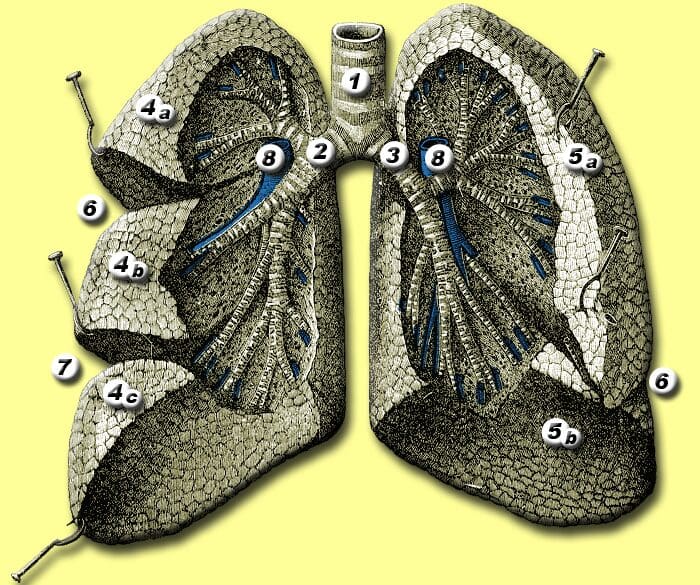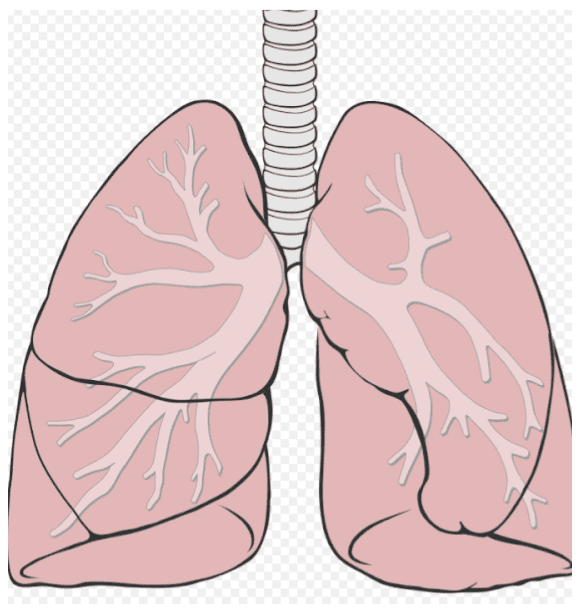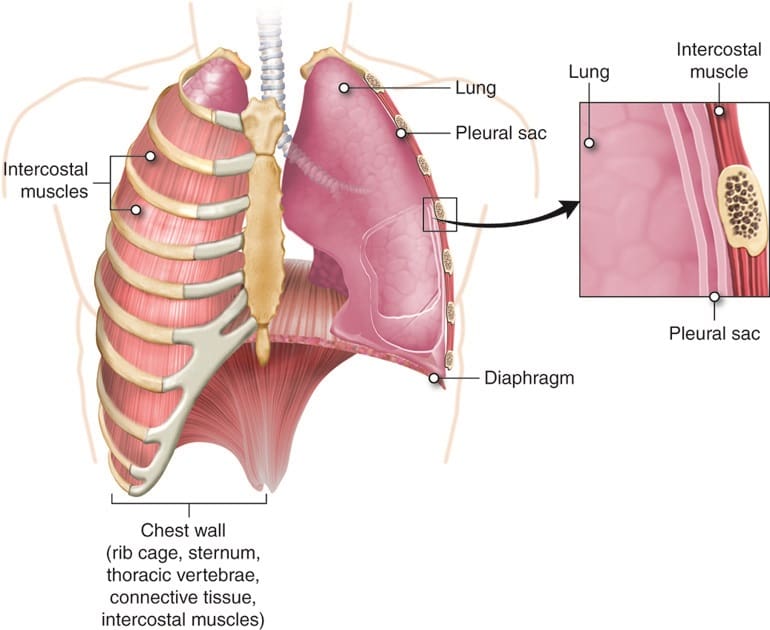10 Fun and Interesting Facts About Lungs
Lungs are a major organ of the respiratory system whose major work is to extract oxygen from the air and transfer it into the bloodstream and also release carbon dioxide from the bloodstream into the atmosphere. They may be found in human beings and many other animals but mostly mammals have two lungs.
The lungs make up a large part of the respiratory system which consists of a network of organs and tissues that allow you to breathe and they are located on the chest (one on each side of the chest) also known as the Thorax. Here are some of the most interesting facts about the lungs;
1. The Lungs are the only organ in the human body that can float on water

BruceBlaus, CC BY-SA 4.0, via Wikimedia Commons
One fun fact in our list today is that they are the only organ in the human body that can float on water, this is because they are filled with air which is denser than water. They are made up of millions of tiny balloon-like structures called Alveoli which are responsible for exchanging carbon dioxide between air and the blood.
Once a person breathes in the Alveoli fill up with air and once we breathe out the air is released though even after breathing out some air is left in the Alveoli. This is because it is very elastic and it tends to hold some air which allows the lungs to float on water.
2. The lung is one of the few organs that works 24/7

Edelhart Kempeneers, Public domain, via Wikimedia Commons
Another interesting fact is that the lung is one of the very few organs in the body that works 24 hours 7 days a week because the body needs continued circulation of oxygen and carbon dioxide between the air and the blood.
Even when one is asleep the lungs are still constantly working this is because the body needs oxygen to produce energy for its cells and that energy is used albeit at a slower rate than when one is awake. The lungs also play a role in regulating blood pressure.
3. The lungs are also very resilient and can heal from damage

LeRoy Woodson, Public domain, via Wikimedia Commons
Another interesting fact about the lungs is that they are very resilient and can heal from damage more so mild damage. This is done by regenerating new lung tissue in a process called Lung regeneration. The process of lung regeneration is a complex process involving a different number of cell types and signaling molecules.
The lungs can heal from damage over time though the healing process may be slow. The lungs however may not be able to fully heal from more severe damage like those caused by smoking or chronic obstructive pulmonary disease (COPD).
4. The lungs also play a role in the production of hormones

Laboratoires Servier, CC BY-SA 3.0, via Wikimedia Commons
The lungs also play a very important role in the production of hormones including angiotensin-converting enzyme that converts Angiotensin I to Angiotensin II and many more. They produce these hormones in response to a variety of stimuli, such as changes in blood pressure, oxygen levels, and carbon dioxide levels.
Some of the other hormones produced in the lungs include melatonin, serotonin, and dopamine. The hormones produced in the lungs play an important role in regulating several bodily functions including blood pressure, fluid balance, and the immune response.
5. The lungs are conical in shape

Gpd2002, CC BY-SA 4.0, via Wikimedia Commons
Another great fact is that the lungs are conical in shape with the apex or tip, pointing upwards and the base resting on the diaphragm. The conical shape of the lungs has several advantages including allowing the lungs to fit snugly into the thoracic cavity, which is the space in the chest that is surrounded by the ribs and spine.
The other important advantage is that the conical shape helps to distribute the weight of the lungs evenly across the thoracic cavity and also the conical shape helps to maximize the surface area of the lungs, which is important for gas exchange.
6. The lungs are very elastic

Patrick J. Lynch, CC BY-SA 2.5, via Wikimedia Commons
The lungs are very elastic and can expand and contract to accommodate different amounts of air. This is because the Alveoli are surrounded by a network of elastic fibers hence when one breathes the diaphragm contracts and the rib cage expands.
The lungs’ being elastic is important for many reasons including helping to keep the airways open and also protecting the lungs from damage. It however decreases with age making older people experience breathing problems but people can do many things to keep the elasticity including exercising regularly.
7. The lungs also play a role in filtering the blood and removing waste product
Another great fact is that the lungs also play a very important role in filtering the blood and removing waste products. This is done through a process called pulmonary circulation which is a movement of blood between the heart and the lungs.
Pulmonary circulation uses a network of macrophages which are white blood cells that engulf and destroy bacteria and other foreign particles. The process is vital for human health since it allows the lungs to exchange oxygen and carbon dioxide between the air and blood, and also helps to filter the blood and remove waste products.
8. There are several things one can do to keep the lungs healthy
There are several things one can do to keep the lungs healthy including quitting smoking which is one of the main causes of lung diseases. Quitting smoking is the best thing one can do for lung health and it is possible with the many resources available like counseling, medication, and even support groups.
Other things include avoiding air pollution, exercising regularly, and eating a healthy diet. They are also advised to get regular checkups get vaccinated against respiratory problems such as pneumonia and influenza and to also avoid secondhand smoke and radonosure.
9. The first lung transplant was performed in 1963
Another interesting fact about lungs is that the first lung transplant was not until June 11, 1963. The transplant was carried out at the University of Mississippi Medical Center in Jackson, Mississippi. It was carried out by Dr. James D. Hardy on a 58-year-old patient with lung cancer but the man only lasted 18 days after the surgery.
The first successful long-term lung transplant was performed in 1981 at Stanford University Medical Center and lung transplant has since become a common procedure in today’s world where people are suffering from several respiratory-related diseases.
10. The lungs are the largest organ in the body by volume

Gray’s Anatomy, Public domain, via Wikimedia Commons
The lungs are the largest organ in the body by volume meaning that they take more space than any other organ in the body. The actual size of an adult lung is around 9 inches and around 10.5 inches when fully expanded. The height of a normal adult lung is around 27cm at total lung capacity.
The lungs when brought together also weigh around 1.3 kilograms (2.9 pounds) and the right lung is bigger than the left lung because it accommodates the heart which is located on the left side of the chest.
In conclusion, the lungs are one of the most important organs in the body with their contribution to the body undisputable which makes them essential for life and makes it important to always be keen on our lungs apart from our health.
Planning a trip to Paris ? Get ready !
These are Amazon’s best-selling travel products that you may need for coming to Paris.
Bookstore
- The best travel book : Rick Steves – Paris 2023 – Learn more here
- Fodor’s Paris 2024 – Learn more here
Travel Gear
- Venture Pal Lightweight Backpack – Learn more here
- Samsonite Winfield 2 28″ Luggage – Learn more here
- Swig Savvy’s Stainless Steel Insulated Water Bottle – Learn more here
Check Amazon’s best-seller list for the most popular travel accessories. We sometimes read this list just to find out what new travel products people are buying.








